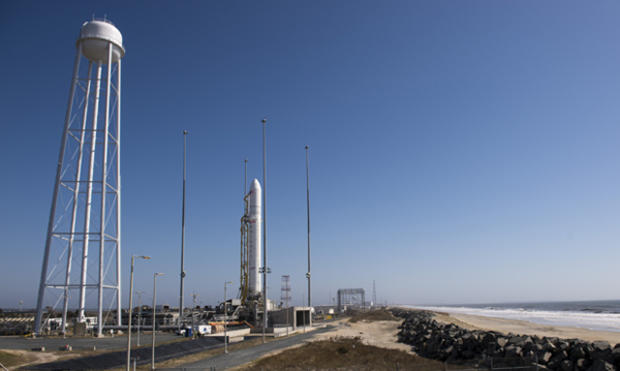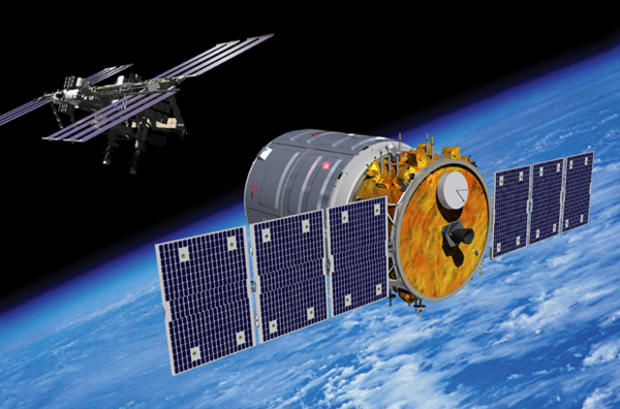Orbital Sciences clears Antares for maiden flight
Orbital Sciences Corp. made final preparations Tuesday for the first test flight of its Antares rocket, a new commercially-built two-stage booster designed to launch unmanned cargo ships to the International Space Station starting later this year.
In another first, the rocket will be launched from the Mid-Atlantic Regional Spaceport -- MARS -- at NASA's Wallops Island Flight Facility on the Virginia coast southeast of Washington, DC, a rural site leased from the space agency by the Virginia Commercial Spaceflight Authority.
After a fueling test over the weekend, engineers decided to replace a first stage engine coolant system valve and mission managers cleared the rocket for a launch attempt at 5 p.m. EDT (GMT-4) Wednesday.
Forecasters are predicting just a 40 percent chance of acceptable weather due to low clouds along the Virginia coast. Backup launch opportunities are available through April 21.
Whenever it goes, the 133-foot-tall Antares, the largest rocket ever launched from the Wallops/MARS complex, is expected to put on quite a show.
"We'll lift off with approximately 750,000 pounds of thrust, weighing about 600,000 pounds," said Frank Culbertson, a former shuttle commander who oversees Orbital's advanced programs group. "So it'll not race off the pad, but it will accelerate very quickly once it gets going.
"And it's going to be the biggest and loudes and brightest thing that's ever launched from Wallops! So it'll be visible up and down the coast."
The Antares test launch is a critical milestone in NASA's long-range plan to ensure a steady flow of supplies and equipment to the space station in the wake of the space shuttle's retirement.
If the test flight goes well, Orbital hopes to launch a second test flight as early as mid June, sending an unmanned Cygnus cargo ship all the way to the space station. The first operational resupply flight is tentatively targeted for mid September.
"I'm very, very gratified to be here today," said Phil McAlister, director of commercial spaceflight development for NASA. "I remember when we first started this program over six years ago there was no launch pad, no rocket. And then to see the launch pad and rocket today, in the sunshine, getting ready for its debut, was very, very gratifying."
Anticipating the space shuttle's retirement, NASA announced a new program in 2006, known as Commercial Orbital Transportation Services, or COTS, that called for development of unmanned cargo craft that would be procured by the government on a commercial basis. The space agency eventually awarded two major contracts.
Orbital Sciences of Dulles, VA, holds a contract valued at $1.9 billion for eight resupply flights to the station to deliver 20 tons of cargo using the Antares rocket and the company-developed Cygnus supply ship. Another $288 million ultimately was budgeted for development, the Antares test flight and the demonstration mission planned for this summer.
"This is a big event for the eastern shore, for Wallops and for everybody in the surrounding area," Culbertson said of the Antares test flight. "But I think also for the country. We've been working on this rocket for over six years. ... (It's) a real honor for us as a company and we understand how important it is for the country."
Space Exploration Technologies, or SpaceX, holds a $1.6 billion contract with NASA to provide 12 cargo flights to the station for delivery of more than 44,000 pounds of equipment and supplies. A separate $396 million contract covered initial test flights.
SpaceX was first out of the gate, successfully launching its Falcon 9 rocket with a dummy payload in 2010. SpaceX then launched two test flights, sending company-built Dragon cargo ships to the station, and two operational resupply missions, the most recent flight in March.
Privately controlled, SpaceX has captured widespread media attention, in large part due to company founder Elon Musk, the colorful entrepreneur and "chief designer" known for his personal involvement in all phases of company activity, including tweets from his launch control center during ascent.
Orbital managers take a more conservative approach to social and traditional media, one more in line with the policies of other large aerospace companies.
"We have been in this business a while, but we do take a little bit different approach," Culbertson said. "We are publicly traded and we have to pay attention to our shareholders and their investments."
Also unlike SpaceX, which builds the Falcon 9 rocket in house with company-designed engines, tanks and other hardware, Orbital opted to build the Antares rocket using components supplied by a variety of subcontractors.
The first stage core vehicle was designed and produced for Orbital by two Russian companies and its two main engines, provided by Aerojet Corp., originally were built to power the Soviet Union's ill-fated N-1 moon rocket. Aerojet bought about 40 of the engines in the mid 1990s, modifying the powerplants as required for use aboard Orbital's Antares rockets.
The Antares second stage uses a solid-fuel motor provided by Alliant Techsystems, or ATK. The rocket also can be launched with a third stage motor, depending on the requirements of the payload.
In its two-stage space station resupply configuration, the Antares and Cygnus supply ship will boost about two tons of supplies to the space station per flight.
For the initial Antares test flight, a dummy payload was mounted inside a protective nose cone fairing that mimics the weight and general shape of a Cygnus cargo ship.
The 8,300-pound "mass simulator," which measures 16.6 feet tall and 9.5 feet wide, is loaded with instrumentation to collect engineering data, including 22 accelerometers, two microphones, 12 strain gauges, 24 thermocouples and 14 digital thermometers.
Unlike SpaceX Falcon 9 missions, which launch from the Cape Canaveral Air Force Station in Florida and follow northeasterly trajectories, the Orbital Antares rocket will be launched to the southeast to avoid flying over populated areas.
The flight plan calls for the rocket to climb straight up for 30 seconds before arcing over toward the southeast. The two Aerojet AJ26-62 first-stage engines are expected to burn for three minutes and 50 seconds, boosting the rocket to an altitude of about 67 miles and a velocity of 9,850 mph.
The ATK solid-fuel second stage motor is expected to burn about two minutes and 35 seconds, pushing the rocket to an altitude of about 160 miles and a velocity of nearly 17,000 mph. Payload separation is scheduled for 10 minutes and three seconds after launch. The Cygnus simulator is expected to re-enter the atmosphere and burn up about two weeks after launch.
"This test flight, of course, is a test flight," Culbertson said. "I want to remind everybody that that first word is 'test.' If things don't go exactly as planned, we will learn what we need to learn and we will press on and continue to improve as we go forward."


